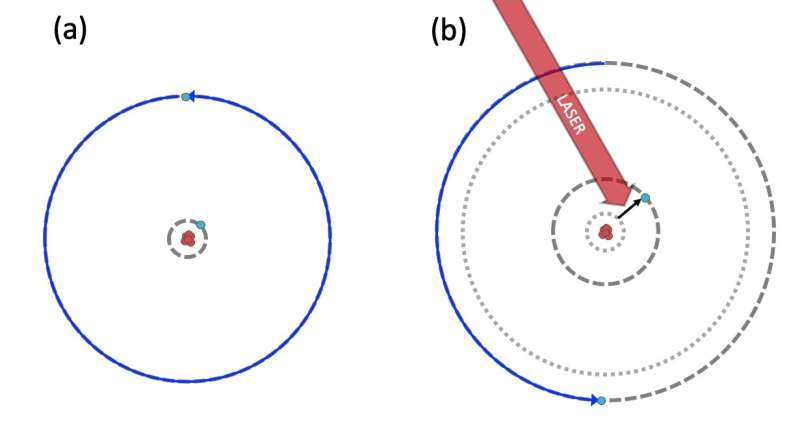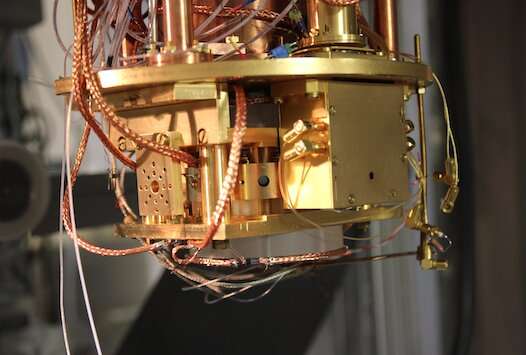April 20, 2022 feature
Study achieves the optical coherent manipulation of circular Rydberg states

Rydberg atoms are excited atoms that contain one or more electrons with a high principal quantum number. Due to their large size, long-range dipole-dipole interactions and strong coupling to external fields, these atoms have proved to be promising systems for the development of quantum technologies.
Despite their advantages, physicists found that optically accessible Rydberg states tend to have a short lifetime, which limits their performance in quantum technology. A possible solution to this problem could be to use circular Rydberg states, with longer lifetimes, yet so far their optical detection has proved to be difficult.
Researchers at ENS-University PSL, Sorbonne Université, Université Paris-Saclay and Universidade Federal de São Carlos have recently demonstrated the coherent manipulation of a circular Rydberg state using optical pulses. Their results, outlined in a paper published in Nature Physics, could open new possibilities for the development of a hybrid optical-microwave platform for quantum technologies.
"Alkaline-earth atoms are interesting for Rydberg physics, because once the first electron is in the Rydberg state, they have a second electron that can still be used to manipulate the atom with lasers," Sébastien Gleyzes, one of the researchers who carried out the study, told Phys.org. "However, one catch is that, if the Rydberg electron 'trajectory' (i.e., its wavefunction) is too elliptical, when the second electron is excited with the laser, the two electrons can collide, which lead to the auto-ionization of the atom."
In their experiments, Gleyzes and his colleagues used circular Rydberg states, states in which the trajectory/wavefunction of a Rydberg atom is 'one circle away' from the ionic core. Due to this circular organization, when a second electron inside the atom is excited, there is a very small chance that it will collide with the first.
"Our initial goal was to demonstrate that we could excite the second electron without the atom ionizing," Gleyzes said. "However, during the course of the experiment, we observed that the transition frequency between two circular Rydberg states was different depending on whether the second electron was in an excited state or not."

Essentially, the researchers found that even though the two valence electrons inside a Rydberg atom remain far away from each other in circular Rydberg states, they can still 'feel each other's presence' through the electrostatic force. They then showed that this 'electrostatic coupling' between the two electrons could be used to coherently manipulate the circular Rydberg state using optical pulses.
"In a classical picture, the frequency at which the Rydberg electron rotates depends on the state of the ionic core electron (let's call it 'up' or 'down')," Gleyzes explained. "We prepared the electron at given position on the orbit and waited for a time T such that the Rydberg electron makes an integer number of rotation if the ionic core is in 'down'. To optically change the state of the Rydberg electron, we transiently send the ionic core electron into other state ('up') with a laser pulse."
By sending the ionic core electron into the second desired state, the researchers slowed down the motion of the electron, which ultimately ends up on the other side of the orbit at the end of the waiting time (i.e., T). In other words, they were able to control the state of the Rydberg electron (which fluctuated between one side and the other of the orbit) by applying or removing a laser pulse.
"We thought that the alkaline earth Rydberg atoms would be interesting because one electron would be used for the quantum processes and the other electron would be used to control the motion of the atom (cool the atom or trap the atom)," Gleyzes said. "Before our study, though, we thought that they would work independently."
The technique to optically manipulate alkaline-earth circular Rydberg states introduced by this team of researchers could open interesting possibilities for the development of quantum technology. In fact, their work is the first to show that the two valence electrons inside alkaline-earth Rydberg atoms are not entirely independent, thus scientists could use one of them to manipulate the other or to detect the other's states.
"The possibility of conditioning the fluorescence of the ionic core electron to the state of the Rydberg electron is extremely promising, for instance if one wants to measure the state of the Rydberg electron non-destructively," Gleyzes added. "Our team's long-term goal is to build a quantum simulator based on the circular states of alkaline-earth atoms."
More information: Andrea Muni et al, Optical coherent manipulation of alkaline-earth circular Rydberg states, Nature Physics (2022). DOI: 10.1038/s41567-022-01519-w
Journal information: Nature Physics
© 2022 Science X Network


















